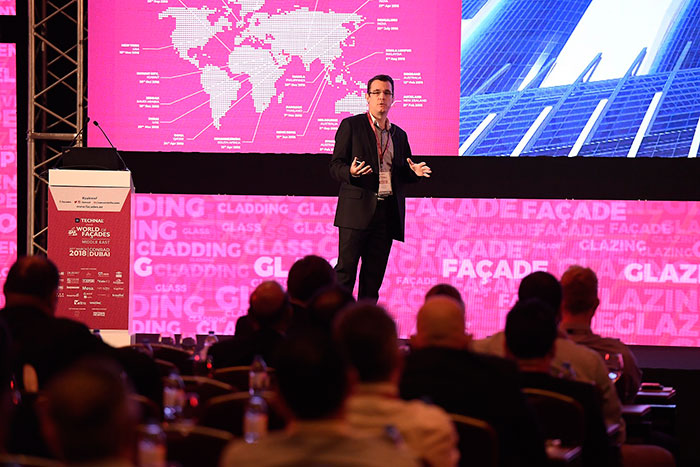Unique façade solutions for energy efficient buildings presented at ZAK World of Façades
 Other News
Other News Subscribe to newsletter
Subscribe to newsletter
| 24 Mar 2018 |
The region’s high temperature and humidity impacts the thermal performance of buildings causing high consumption of energy. Over 400 participants at ZAK World of Façades listened to industry experts present the best façade solutions to reduce energy consumption in the Middle East, and to safeguard buildings from fire and smoke related hazards. According to speaker Jason Pardesi, General Manager, Wintech Middle East, 80% of all the energy produced in the UAE is consumed by buildings. In Dubai, residential buildings consume more than commercial buildings. The current building stock is inefficient with some buildings being thought to consume 220-360 kwh/m2/year. Best practice in the UAE shows its most energy efficient buildings consuming 110-160 kwh/m2. The aim, as detailed at the Emirates Energy Efficient Summit 2016, is to reduce this to 40-60 kwh/m2/year.

He also highlighted that thermal engineering is of great importance in the UAE due to chances for fire blaze during summer. The actual façade performance companies are achieving in Dubai is often not what they set out to achieve. Reducing or accounting for linear and point thermal bridging is an important part of the design process. Balcony Linear thermal bridges can reduce heat by affecting the U-values by 9-18% which proves that thermal engineering and thermal bridging carries a great value in construction. He stressed on the importance of Air Tightness in achieving desired envelope performance and the discomfort they can cause to the tenants if not monitored properly during construction. As a solution, the construction process should be monitored effectively and in that case the cooling loads will be reduced by up to 8% for the worst buildings if the air tightness is controlled.
Werner Jaeger, Director Technology & Marketing, Hydro Building Systems talked about the cities of the future and the main challenges they look at when constructing buildings- heat, dust, smog, noise and fire. In the UAE and the region, there have been many instances of fire that has prompted the new UAE Fire and Safety Code that outlines stringent measures and regulations that building contractors must follow to protect façades; and one such requirement is compliance with EN-1364-4 fire resistance test for curtain wall assembly. He highlighted Technal’s new non-fire-rated curtain wall assembly with Siderise perimeter fire protection have successfully undergone the EN-1364-4 fire resistance test required in the UAE.
The conference focused on the new and emerging façade materials such as liquid glass and carbon fiber. Carbon fiber is a type of façade which is much stronger in strength compared to steel although it is much lighter in weight; therefore, the carbon fiber is now being increasingly used in architectural projects, said Mathieu Meur, Director at DP architect during his presentation. He also spoke on the latest emerging materials in facades which is the liquid glass, a type of glass that reflects the heat back to its source depending on the amount of light coming in.
The event also had two panel discussions. One, on digital impact on modern façade design and construction and another on façade engineering matrix for desired project delivery targets.
Technal was the presenting sponsor of the one-day conference at Conrad Hotel, Dubai. Associate partners included Alupex, Calostat, Calvi Network, CN Ceramic, Dow Corning, Elval Colour, Future Architectural Glass, Jotun, Kingspan, Kinlong Hardware, Mosa, Neolith, SageGlass, Sefar, Serge Ferrari, Siderise, Technoform, Trosifol, Vitro and VMZINC.




